Analysis of High Stakes Testing Debate on Student Wellbeing
VerifiedAdded on 2022/11/28
|8
|2246
|201
Report
AI Summary
This report analyzes a debate concerning the abolishment of high-stakes testing, particularly focusing on its implications for student health and wellbeing within the Australian education system. The report examines arguments from both sides of the debate, highlighting the detrimental effects of high-stakes testing, such as NAPLAN, on student psychological, cognitive, and physical well-being, including increased anxiety and stress, and even unethical practices by teachers. Supporters argue that high-stakes tests are responsible for increased prevalence of stress and anxiety disorders, while opponents suggest that these tests help determine educational outcomes, improve learning abilities and manage stress effectively. The report also explores fallacies in reasoning, alternative policy suggestions, and the broader implications of the debate for the health and well-being of the Australian population, referencing various studies and surveys to support its claims. The report emphasizes the need for a more holistic approach that prioritizes student well-being and quality learning over standardized test results.
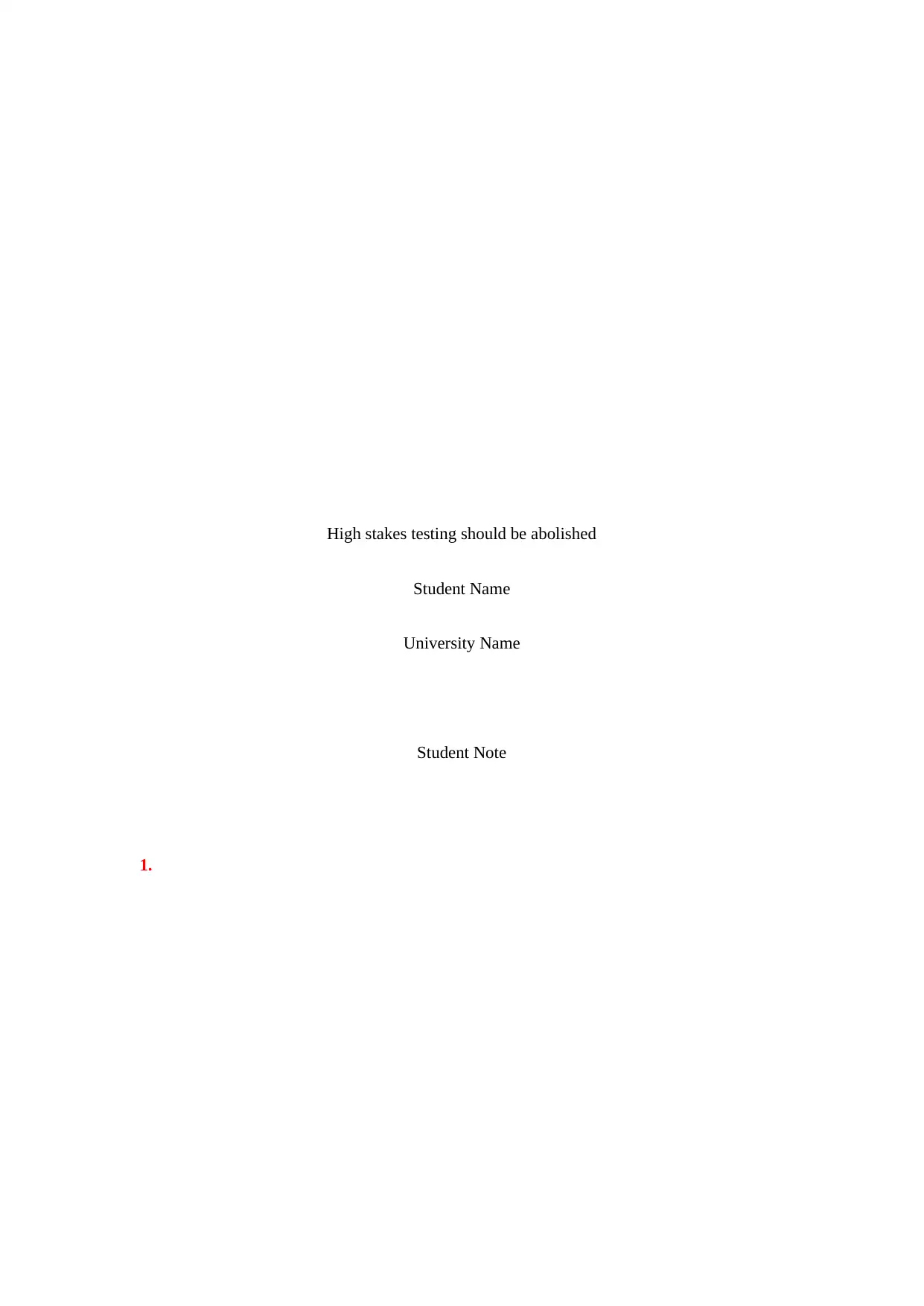
High stakes testing should be abolished
Student Name
University Name
Student Note
1.
Student Name
University Name
Student Note
1.
Paraphrase This Document
Need a fresh take? Get an instant paraphrase of this document with our AI Paraphraser
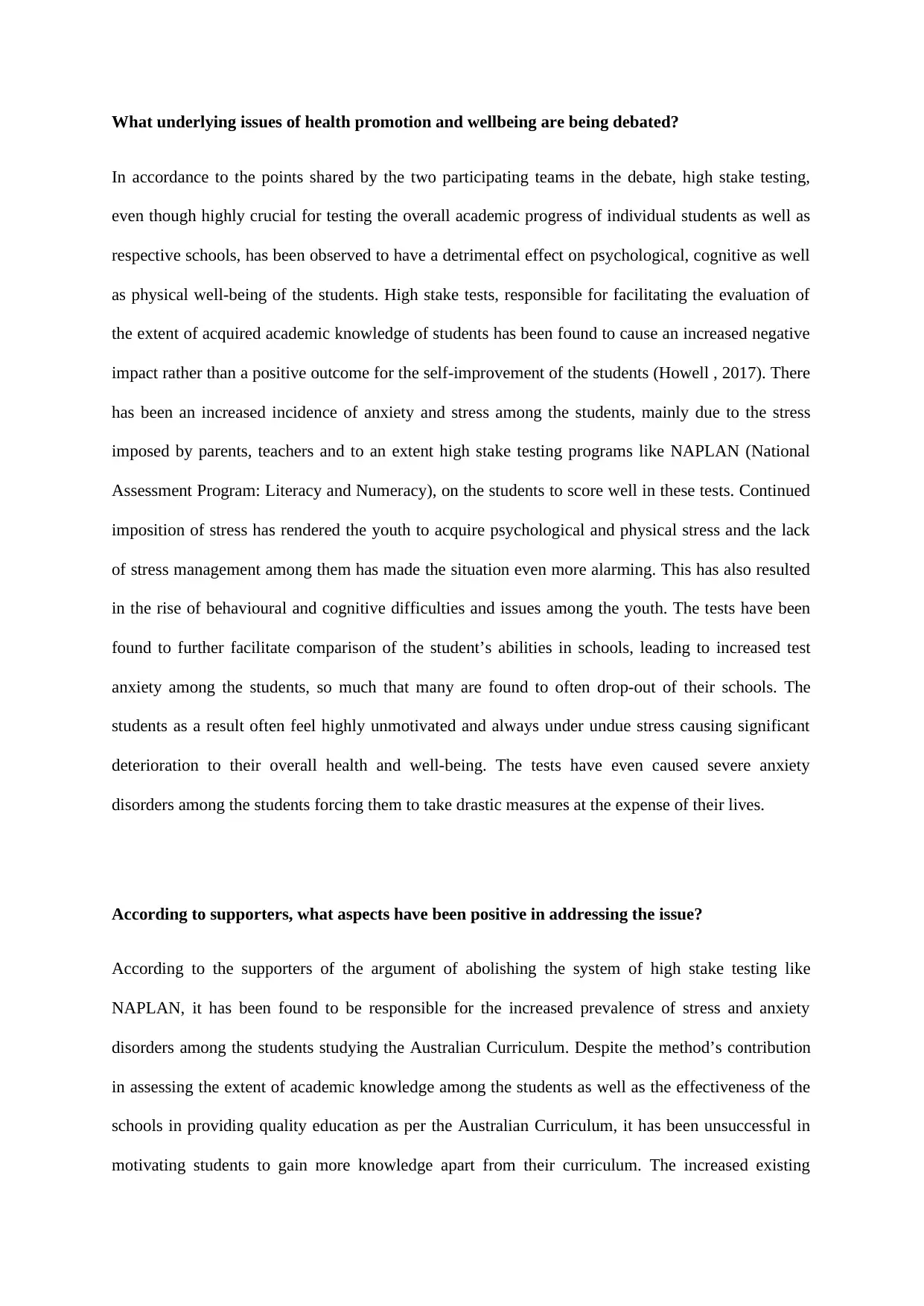
What underlying issues of health promotion and wellbeing are being debated?
In accordance to the points shared by the two participating teams in the debate, high stake testing,
even though highly crucial for testing the overall academic progress of individual students as well as
respective schools, has been observed to have a detrimental effect on psychological, cognitive as well
as physical well-being of the students. High stake tests, responsible for facilitating the evaluation of
the extent of acquired academic knowledge of students has been found to cause an increased negative
impact rather than a positive outcome for the self-improvement of the students (Howell , 2017). There
has been an increased incidence of anxiety and stress among the students, mainly due to the stress
imposed by parents, teachers and to an extent high stake testing programs like NAPLAN (National
Assessment Program: Literacy and Numeracy), on the students to score well in these tests. Continued
imposition of stress has rendered the youth to acquire psychological and physical stress and the lack
of stress management among them has made the situation even more alarming. This has also resulted
in the rise of behavioural and cognitive difficulties and issues among the youth. The tests have been
found to further facilitate comparison of the student’s abilities in schools, leading to increased test
anxiety among the students, so much that many are found to often drop-out of their schools. The
students as a result often feel highly unmotivated and always under undue stress causing significant
deterioration to their overall health and well-being. The tests have even caused severe anxiety
disorders among the students forcing them to take drastic measures at the expense of their lives.
According to supporters, what aspects have been positive in addressing the issue?
According to the supporters of the argument of abolishing the system of high stake testing like
NAPLAN, it has been found to be responsible for the increased prevalence of stress and anxiety
disorders among the students studying the Australian Curriculum. Despite the method’s contribution
in assessing the extent of academic knowledge among the students as well as the effectiveness of the
schools in providing quality education as per the Australian Curriculum, it has been unsuccessful in
motivating students to gain more knowledge apart from their curriculum. The increased existing
In accordance to the points shared by the two participating teams in the debate, high stake testing,
even though highly crucial for testing the overall academic progress of individual students as well as
respective schools, has been observed to have a detrimental effect on psychological, cognitive as well
as physical well-being of the students. High stake tests, responsible for facilitating the evaluation of
the extent of acquired academic knowledge of students has been found to cause an increased negative
impact rather than a positive outcome for the self-improvement of the students (Howell , 2017). There
has been an increased incidence of anxiety and stress among the students, mainly due to the stress
imposed by parents, teachers and to an extent high stake testing programs like NAPLAN (National
Assessment Program: Literacy and Numeracy), on the students to score well in these tests. Continued
imposition of stress has rendered the youth to acquire psychological and physical stress and the lack
of stress management among them has made the situation even more alarming. This has also resulted
in the rise of behavioural and cognitive difficulties and issues among the youth. The tests have been
found to further facilitate comparison of the student’s abilities in schools, leading to increased test
anxiety among the students, so much that many are found to often drop-out of their schools. The
students as a result often feel highly unmotivated and always under undue stress causing significant
deterioration to their overall health and well-being. The tests have even caused severe anxiety
disorders among the students forcing them to take drastic measures at the expense of their lives.
According to supporters, what aspects have been positive in addressing the issue?
According to the supporters of the argument of abolishing the system of high stake testing like
NAPLAN, it has been found to be responsible for the increased prevalence of stress and anxiety
disorders among the students studying the Australian Curriculum. Despite the method’s contribution
in assessing the extent of academic knowledge among the students as well as the effectiveness of the
schools in providing quality education as per the Australian Curriculum, it has been unsuccessful in
motivating students to gain more knowledge apart from their curriculum. The increased existing
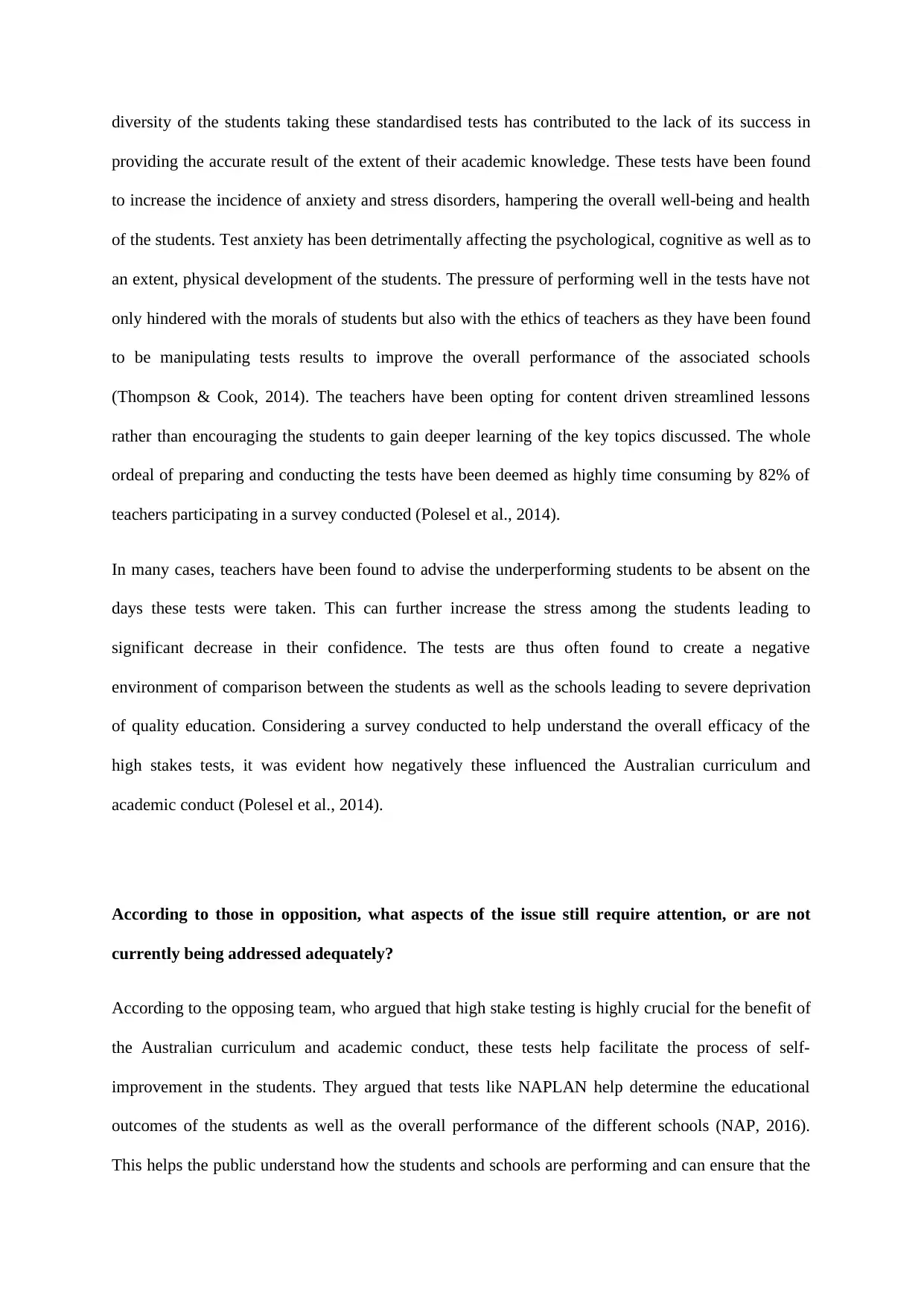
diversity of the students taking these standardised tests has contributed to the lack of its success in
providing the accurate result of the extent of their academic knowledge. These tests have been found
to increase the incidence of anxiety and stress disorders, hampering the overall well-being and health
of the students. Test anxiety has been detrimentally affecting the psychological, cognitive as well as to
an extent, physical development of the students. The pressure of performing well in the tests have not
only hindered with the morals of students but also with the ethics of teachers as they have been found
to be manipulating tests results to improve the overall performance of the associated schools
(Thompson & Cook, 2014). The teachers have been opting for content driven streamlined lessons
rather than encouraging the students to gain deeper learning of the key topics discussed. The whole
ordeal of preparing and conducting the tests have been deemed as highly time consuming by 82% of
teachers participating in a survey conducted (Polesel et al., 2014).
In many cases, teachers have been found to advise the underperforming students to be absent on the
days these tests were taken. This can further increase the stress among the students leading to
significant decrease in their confidence. The tests are thus often found to create a negative
environment of comparison between the students as well as the schools leading to severe deprivation
of quality education. Considering a survey conducted to help understand the overall efficacy of the
high stakes tests, it was evident how negatively these influenced the Australian curriculum and
academic conduct (Polesel et al., 2014).
According to those in opposition, what aspects of the issue still require attention, or are not
currently being addressed adequately?
According to the opposing team, who argued that high stake testing is highly crucial for the benefit of
the Australian curriculum and academic conduct, these tests help facilitate the process of self-
improvement in the students. They argued that tests like NAPLAN help determine the educational
outcomes of the students as well as the overall performance of the different schools (NAP, 2016).
This helps the public understand how the students and schools are performing and can ensure that the
providing the accurate result of the extent of their academic knowledge. These tests have been found
to increase the incidence of anxiety and stress disorders, hampering the overall well-being and health
of the students. Test anxiety has been detrimentally affecting the psychological, cognitive as well as to
an extent, physical development of the students. The pressure of performing well in the tests have not
only hindered with the morals of students but also with the ethics of teachers as they have been found
to be manipulating tests results to improve the overall performance of the associated schools
(Thompson & Cook, 2014). The teachers have been opting for content driven streamlined lessons
rather than encouraging the students to gain deeper learning of the key topics discussed. The whole
ordeal of preparing and conducting the tests have been deemed as highly time consuming by 82% of
teachers participating in a survey conducted (Polesel et al., 2014).
In many cases, teachers have been found to advise the underperforming students to be absent on the
days these tests were taken. This can further increase the stress among the students leading to
significant decrease in their confidence. The tests are thus often found to create a negative
environment of comparison between the students as well as the schools leading to severe deprivation
of quality education. Considering a survey conducted to help understand the overall efficacy of the
high stakes tests, it was evident how negatively these influenced the Australian curriculum and
academic conduct (Polesel et al., 2014).
According to those in opposition, what aspects of the issue still require attention, or are not
currently being addressed adequately?
According to the opposing team, who argued that high stake testing is highly crucial for the benefit of
the Australian curriculum and academic conduct, these tests help facilitate the process of self-
improvement in the students. They argued that tests like NAPLAN help determine the educational
outcomes of the students as well as the overall performance of the different schools (NAP, 2016).
This helps the public understand how the students and schools are performing and can ensure that the
⊘ This is a preview!⊘
Do you want full access?
Subscribe today to unlock all pages.

Trusted by 1+ million students worldwide
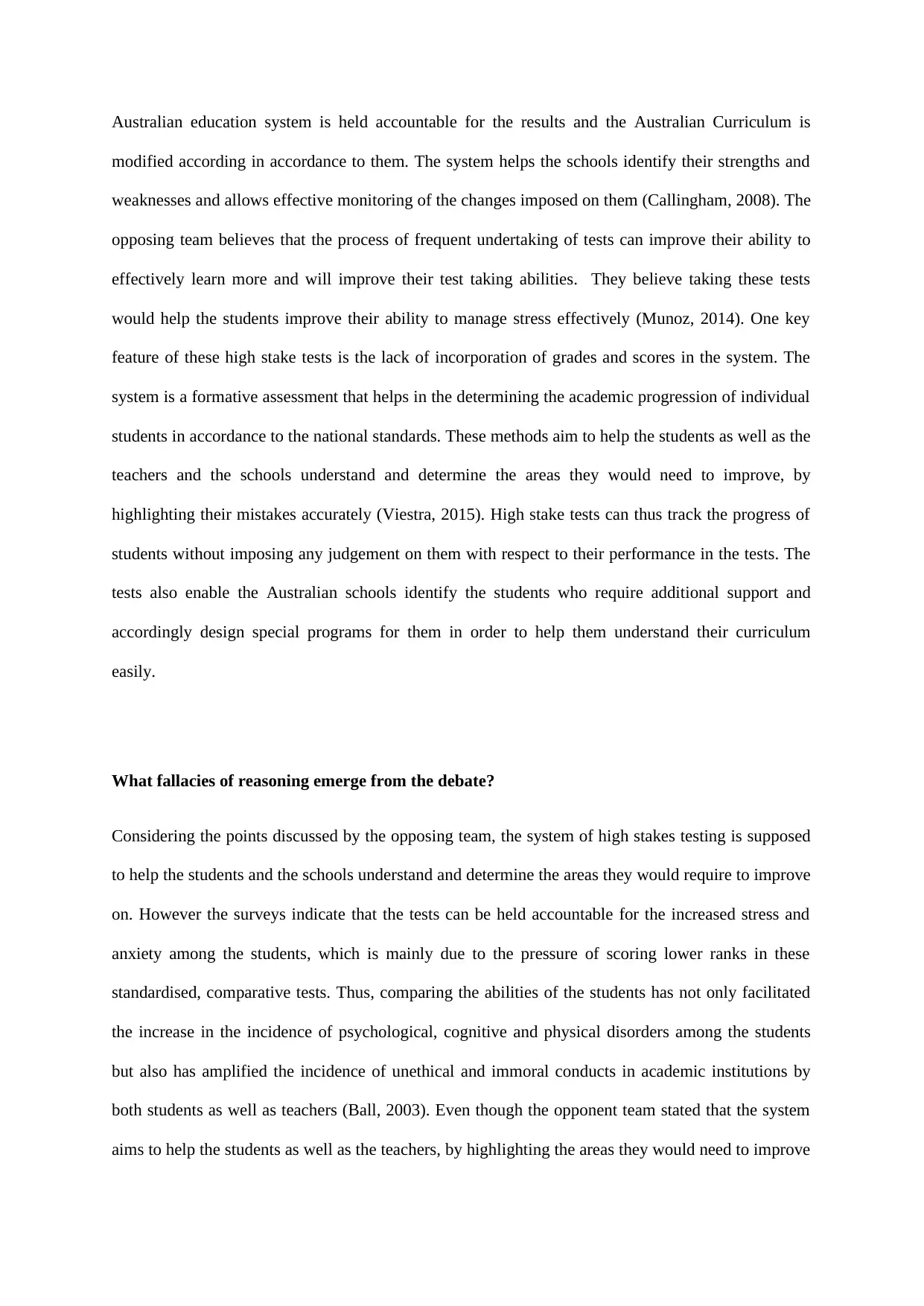
Australian education system is held accountable for the results and the Australian Curriculum is
modified according in accordance to them. The system helps the schools identify their strengths and
weaknesses and allows effective monitoring of the changes imposed on them (Callingham, 2008). The
opposing team believes that the process of frequent undertaking of tests can improve their ability to
effectively learn more and will improve their test taking abilities. They believe taking these tests
would help the students improve their ability to manage stress effectively (Munoz, 2014). One key
feature of these high stake tests is the lack of incorporation of grades and scores in the system. The
system is a formative assessment that helps in the determining the academic progression of individual
students in accordance to the national standards. These methods aim to help the students as well as the
teachers and the schools understand and determine the areas they would need to improve, by
highlighting their mistakes accurately (Viestra, 2015). High stake tests can thus track the progress of
students without imposing any judgement on them with respect to their performance in the tests. The
tests also enable the Australian schools identify the students who require additional support and
accordingly design special programs for them in order to help them understand their curriculum
easily.
What fallacies of reasoning emerge from the debate?
Considering the points discussed by the opposing team, the system of high stakes testing is supposed
to help the students and the schools understand and determine the areas they would require to improve
on. However the surveys indicate that the tests can be held accountable for the increased stress and
anxiety among the students, which is mainly due to the pressure of scoring lower ranks in these
standardised, comparative tests. Thus, comparing the abilities of the students has not only facilitated
the increase in the incidence of psychological, cognitive and physical disorders among the students
but also has amplified the incidence of unethical and immoral conducts in academic institutions by
both students as well as teachers (Ball, 2003). Even though the opponent team stated that the system
aims to help the students as well as the teachers, by highlighting the areas they would need to improve
modified according in accordance to them. The system helps the schools identify their strengths and
weaknesses and allows effective monitoring of the changes imposed on them (Callingham, 2008). The
opposing team believes that the process of frequent undertaking of tests can improve their ability to
effectively learn more and will improve their test taking abilities. They believe taking these tests
would help the students improve their ability to manage stress effectively (Munoz, 2014). One key
feature of these high stake tests is the lack of incorporation of grades and scores in the system. The
system is a formative assessment that helps in the determining the academic progression of individual
students in accordance to the national standards. These methods aim to help the students as well as the
teachers and the schools understand and determine the areas they would need to improve, by
highlighting their mistakes accurately (Viestra, 2015). High stake tests can thus track the progress of
students without imposing any judgement on them with respect to their performance in the tests. The
tests also enable the Australian schools identify the students who require additional support and
accordingly design special programs for them in order to help them understand their curriculum
easily.
What fallacies of reasoning emerge from the debate?
Considering the points discussed by the opposing team, the system of high stakes testing is supposed
to help the students and the schools understand and determine the areas they would require to improve
on. However the surveys indicate that the tests can be held accountable for the increased stress and
anxiety among the students, which is mainly due to the pressure of scoring lower ranks in these
standardised, comparative tests. Thus, comparing the abilities of the students has not only facilitated
the increase in the incidence of psychological, cognitive and physical disorders among the students
but also has amplified the incidence of unethical and immoral conducts in academic institutions by
both students as well as teachers (Ball, 2003). Even though the opponent team stated that the system
aims to help the students as well as the teachers, by highlighting the areas they would need to improve
Paraphrase This Document
Need a fresh take? Get an instant paraphrase of this document with our AI Paraphraser
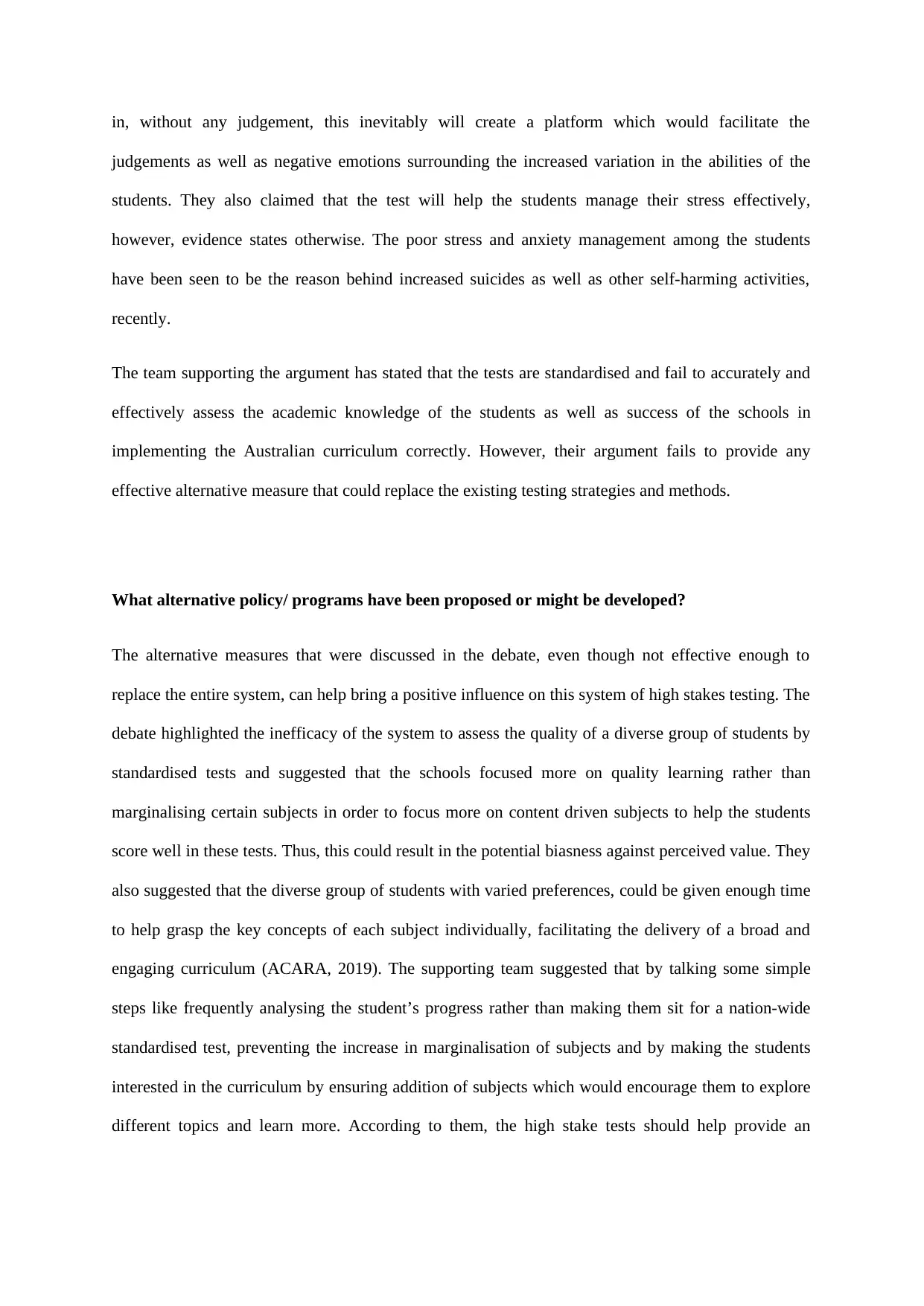
in, without any judgement, this inevitably will create a platform which would facilitate the
judgements as well as negative emotions surrounding the increased variation in the abilities of the
students. They also claimed that the test will help the students manage their stress effectively,
however, evidence states otherwise. The poor stress and anxiety management among the students
have been seen to be the reason behind increased suicides as well as other self-harming activities,
recently.
The team supporting the argument has stated that the tests are standardised and fail to accurately and
effectively assess the academic knowledge of the students as well as success of the schools in
implementing the Australian curriculum correctly. However, their argument fails to provide any
effective alternative measure that could replace the existing testing strategies and methods.
What alternative policy/ programs have been proposed or might be developed?
The alternative measures that were discussed in the debate, even though not effective enough to
replace the entire system, can help bring a positive influence on this system of high stakes testing. The
debate highlighted the inefficacy of the system to assess the quality of a diverse group of students by
standardised tests and suggested that the schools focused more on quality learning rather than
marginalising certain subjects in order to focus more on content driven subjects to help the students
score well in these tests. Thus, this could result in the potential biasness against perceived value. They
also suggested that the diverse group of students with varied preferences, could be given enough time
to help grasp the key concepts of each subject individually, facilitating the delivery of a broad and
engaging curriculum (ACARA, 2019). The supporting team suggested that by talking some simple
steps like frequently analysing the student’s progress rather than making them sit for a nation-wide
standardised test, preventing the increase in marginalisation of subjects and by making the students
interested in the curriculum by ensuring addition of subjects which would encourage them to explore
different topics and learn more. According to them, the high stake tests should help provide an
judgements as well as negative emotions surrounding the increased variation in the abilities of the
students. They also claimed that the test will help the students manage their stress effectively,
however, evidence states otherwise. The poor stress and anxiety management among the students
have been seen to be the reason behind increased suicides as well as other self-harming activities,
recently.
The team supporting the argument has stated that the tests are standardised and fail to accurately and
effectively assess the academic knowledge of the students as well as success of the schools in
implementing the Australian curriculum correctly. However, their argument fails to provide any
effective alternative measure that could replace the existing testing strategies and methods.
What alternative policy/ programs have been proposed or might be developed?
The alternative measures that were discussed in the debate, even though not effective enough to
replace the entire system, can help bring a positive influence on this system of high stakes testing. The
debate highlighted the inefficacy of the system to assess the quality of a diverse group of students by
standardised tests and suggested that the schools focused more on quality learning rather than
marginalising certain subjects in order to focus more on content driven subjects to help the students
score well in these tests. Thus, this could result in the potential biasness against perceived value. They
also suggested that the diverse group of students with varied preferences, could be given enough time
to help grasp the key concepts of each subject individually, facilitating the delivery of a broad and
engaging curriculum (ACARA, 2019). The supporting team suggested that by talking some simple
steps like frequently analysing the student’s progress rather than making them sit for a nation-wide
standardised test, preventing the increase in marginalisation of subjects and by making the students
interested in the curriculum by ensuring addition of subjects which would encourage them to explore
different topics and learn more. According to them, the high stake tests should help provide an
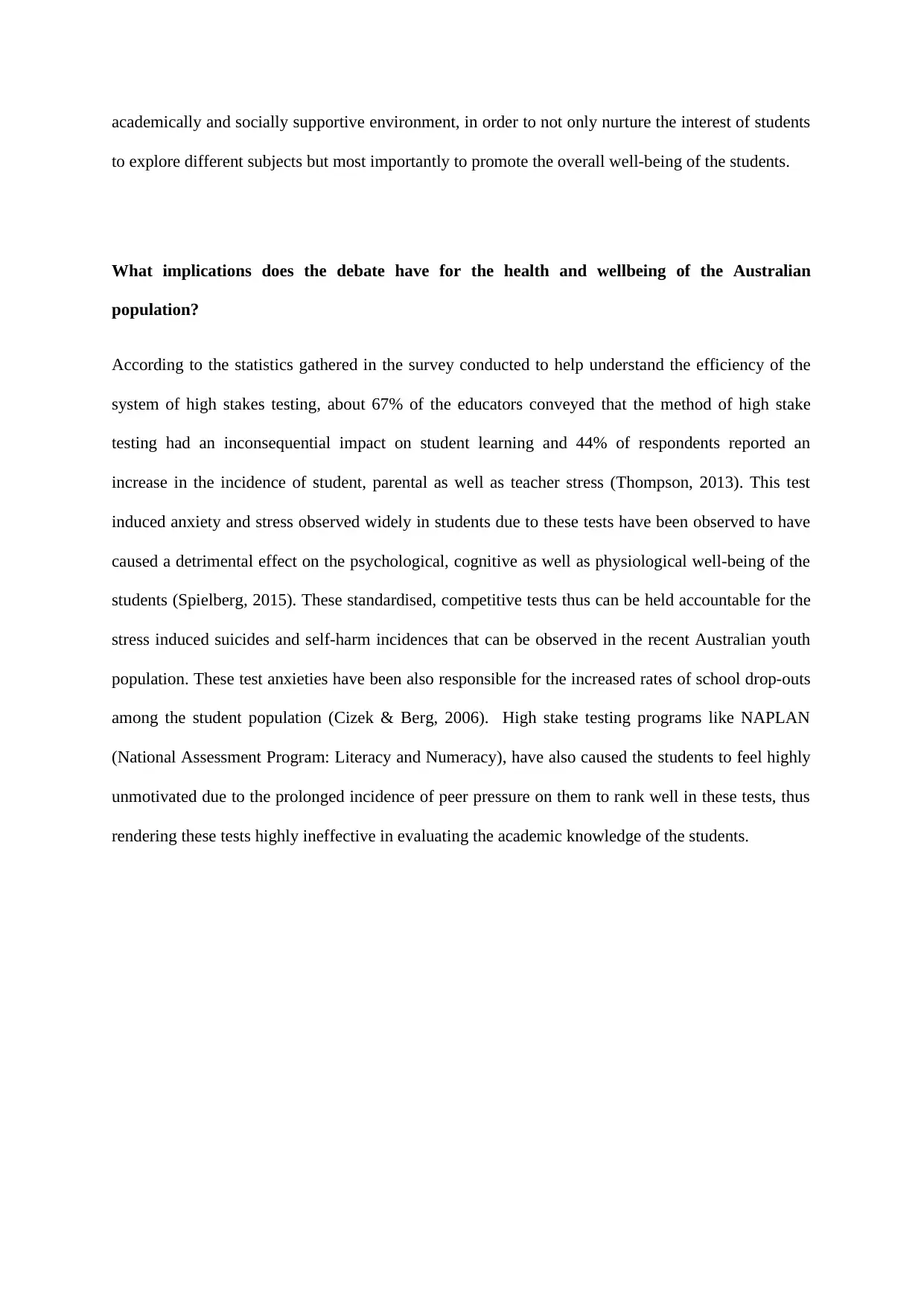
academically and socially supportive environment, in order to not only nurture the interest of students
to explore different subjects but most importantly to promote the overall well-being of the students.
What implications does the debate have for the health and wellbeing of the Australian
population?
According to the statistics gathered in the survey conducted to help understand the efficiency of the
system of high stakes testing, about 67% of the educators conveyed that the method of high stake
testing had an inconsequential impact on student learning and 44% of respondents reported an
increase in the incidence of student, parental as well as teacher stress (Thompson, 2013). This test
induced anxiety and stress observed widely in students due to these tests have been observed to have
caused a detrimental effect on the psychological, cognitive as well as physiological well-being of the
students (Spielberg, 2015). These standardised, competitive tests thus can be held accountable for the
stress induced suicides and self-harm incidences that can be observed in the recent Australian youth
population. These test anxieties have been also responsible for the increased rates of school drop-outs
among the student population (Cizek & Berg, 2006). High stake testing programs like NAPLAN
(National Assessment Program: Literacy and Numeracy), have also caused the students to feel highly
unmotivated due to the prolonged incidence of peer pressure on them to rank well in these tests, thus
rendering these tests highly ineffective in evaluating the academic knowledge of the students.
to explore different subjects but most importantly to promote the overall well-being of the students.
What implications does the debate have for the health and wellbeing of the Australian
population?
According to the statistics gathered in the survey conducted to help understand the efficiency of the
system of high stakes testing, about 67% of the educators conveyed that the method of high stake
testing had an inconsequential impact on student learning and 44% of respondents reported an
increase in the incidence of student, parental as well as teacher stress (Thompson, 2013). This test
induced anxiety and stress observed widely in students due to these tests have been observed to have
caused a detrimental effect on the psychological, cognitive as well as physiological well-being of the
students (Spielberg, 2015). These standardised, competitive tests thus can be held accountable for the
stress induced suicides and self-harm incidences that can be observed in the recent Australian youth
population. These test anxieties have been also responsible for the increased rates of school drop-outs
among the student population (Cizek & Berg, 2006). High stake testing programs like NAPLAN
(National Assessment Program: Literacy and Numeracy), have also caused the students to feel highly
unmotivated due to the prolonged incidence of peer pressure on them to rank well in these tests, thus
rendering these tests highly ineffective in evaluating the academic knowledge of the students.
⊘ This is a preview!⊘
Do you want full access?
Subscribe today to unlock all pages.

Trusted by 1+ million students worldwide
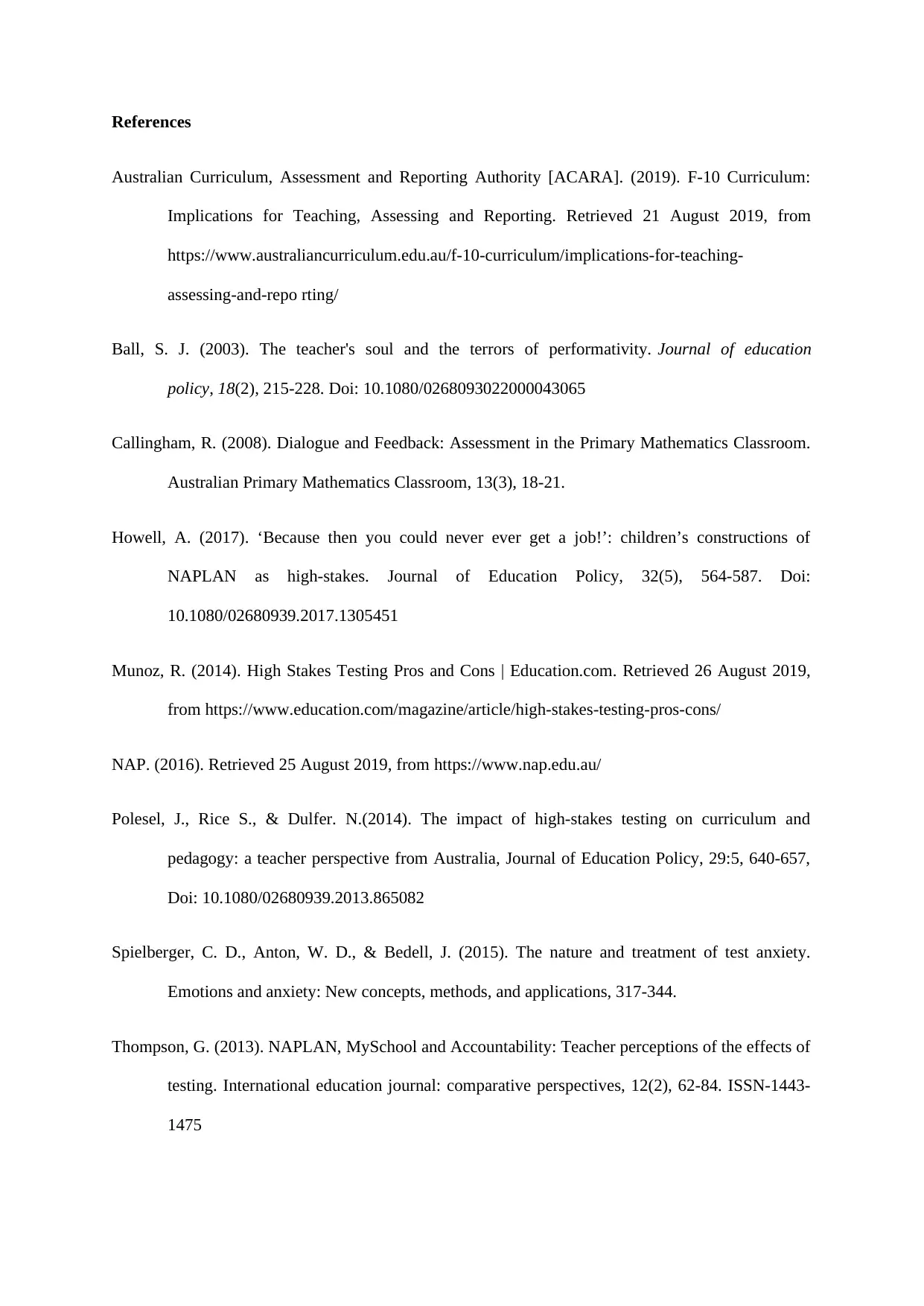
References
Australian Curriculum, Assessment and Reporting Authority [ACARA]. (2019). F-10 Curriculum:
Implications for Teaching, Assessing and Reporting. Retrieved 21 August 2019, from
https://www.australiancurriculum.edu.au/f-10-curriculum/implications-for-teaching-
assessing-and-repo rting/
Ball, S. J. (2003). The teacher's soul and the terrors of performativity. Journal of education
policy, 18(2), 215-228. Doi: 10.1080/0268093022000043065
Callingham, R. (2008). Dialogue and Feedback: Assessment in the Primary Mathematics Classroom.
Australian Primary Mathematics Classroom, 13(3), 18-21.
Howell, A. (2017). ‘Because then you could never ever get a job!’: children’s constructions of
NAPLAN as high-stakes. Journal of Education Policy, 32(5), 564-587. Doi:
10.1080/02680939.2017.1305451
Munoz, R. (2014). High Stakes Testing Pros and Cons | Education.com. Retrieved 26 August 2019,
from https://www.education.com/magazine/article/high-stakes-testing-pros-cons/
NAP. (2016). Retrieved 25 August 2019, from https://www.nap.edu.au/
Polesel, J., Rice S., & Dulfer. N.(2014). The impact of high-stakes testing on curriculum and
pedagogy: a teacher perspective from Australia, Journal of Education Policy, 29:5, 640-657,
Doi: 10.1080/02680939.2013.865082
Spielberger, C. D., Anton, W. D., & Bedell, J. (2015). The nature and treatment of test anxiety.
Emotions and anxiety: New concepts, methods, and applications, 317-344.
Thompson, G. (2013). NAPLAN, MySchool and Accountability: Teacher perceptions of the effects of
testing. International education journal: comparative perspectives, 12(2), 62-84. ISSN-1443-
1475
Australian Curriculum, Assessment and Reporting Authority [ACARA]. (2019). F-10 Curriculum:
Implications for Teaching, Assessing and Reporting. Retrieved 21 August 2019, from
https://www.australiancurriculum.edu.au/f-10-curriculum/implications-for-teaching-
assessing-and-repo rting/
Ball, S. J. (2003). The teacher's soul and the terrors of performativity. Journal of education
policy, 18(2), 215-228. Doi: 10.1080/0268093022000043065
Callingham, R. (2008). Dialogue and Feedback: Assessment in the Primary Mathematics Classroom.
Australian Primary Mathematics Classroom, 13(3), 18-21.
Howell, A. (2017). ‘Because then you could never ever get a job!’: children’s constructions of
NAPLAN as high-stakes. Journal of Education Policy, 32(5), 564-587. Doi:
10.1080/02680939.2017.1305451
Munoz, R. (2014). High Stakes Testing Pros and Cons | Education.com. Retrieved 26 August 2019,
from https://www.education.com/magazine/article/high-stakes-testing-pros-cons/
NAP. (2016). Retrieved 25 August 2019, from https://www.nap.edu.au/
Polesel, J., Rice S., & Dulfer. N.(2014). The impact of high-stakes testing on curriculum and
pedagogy: a teacher perspective from Australia, Journal of Education Policy, 29:5, 640-657,
Doi: 10.1080/02680939.2013.865082
Spielberger, C. D., Anton, W. D., & Bedell, J. (2015). The nature and treatment of test anxiety.
Emotions and anxiety: New concepts, methods, and applications, 317-344.
Thompson, G. (2013). NAPLAN, MySchool and Accountability: Teacher perceptions of the effects of
testing. International education journal: comparative perspectives, 12(2), 62-84. ISSN-1443-
1475
Paraphrase This Document
Need a fresh take? Get an instant paraphrase of this document with our AI Paraphraser
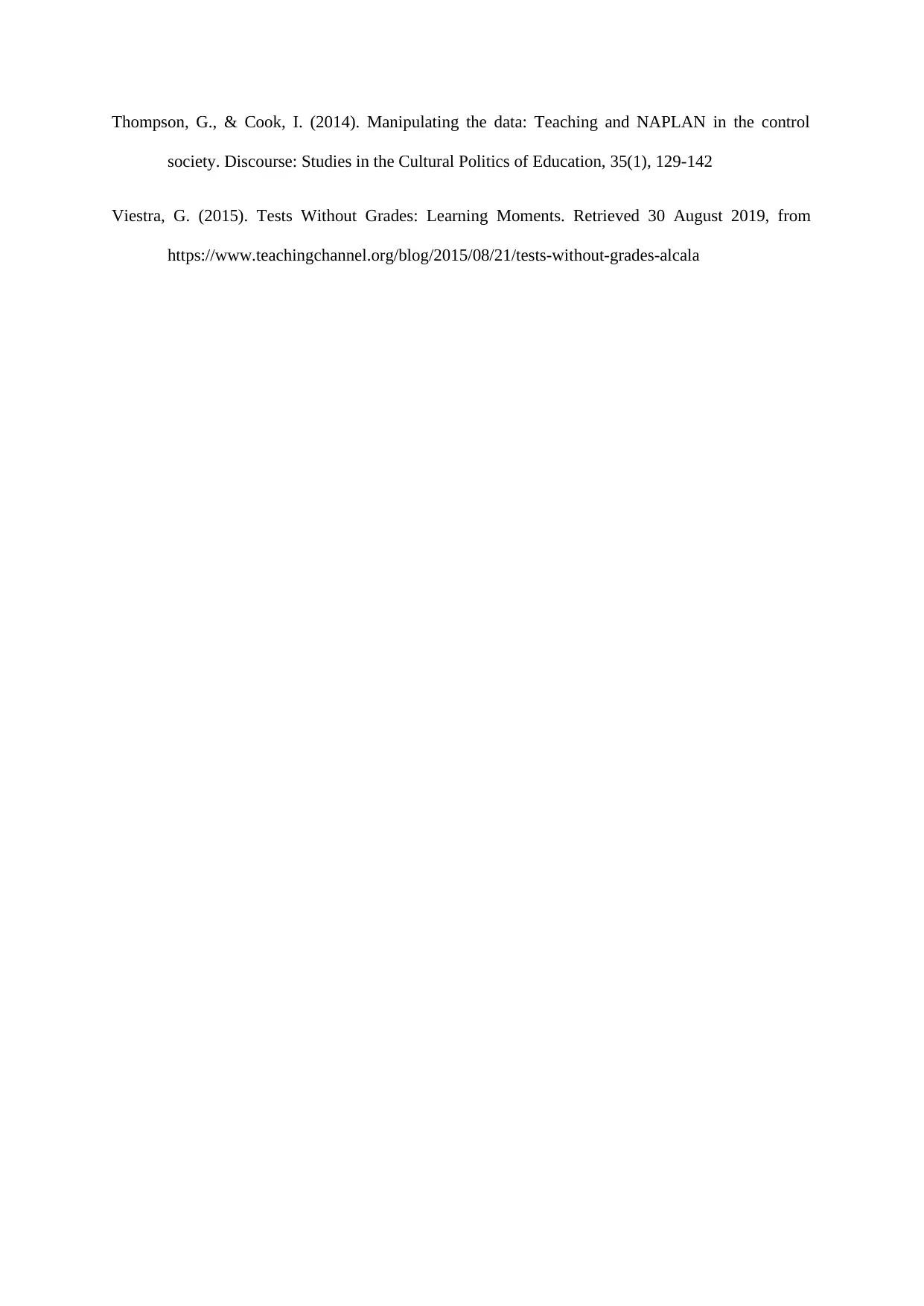
Thompson, G., & Cook, I. (2014). Manipulating the data: Teaching and NAPLAN in the control
society. Discourse: Studies in the Cultural Politics of Education, 35(1), 129-142
Viestra, G. (2015). Tests Without Grades: Learning Moments. Retrieved 30 August 2019, from
https://www.teachingchannel.org/blog/2015/08/21/tests-without-grades-alcala
society. Discourse: Studies in the Cultural Politics of Education, 35(1), 129-142
Viestra, G. (2015). Tests Without Grades: Learning Moments. Retrieved 30 August 2019, from
https://www.teachingchannel.org/blog/2015/08/21/tests-without-grades-alcala
1 out of 8
Related Documents
Your All-in-One AI-Powered Toolkit for Academic Success.
+13062052269
info@desklib.com
Available 24*7 on WhatsApp / Email
![[object Object]](/_next/static/media/star-bottom.7253800d.svg)
Unlock your academic potential
Copyright © 2020–2025 A2Z Services. All Rights Reserved. Developed and managed by ZUCOL.





